SCUP Journal Feature: University-Industry Partnerships
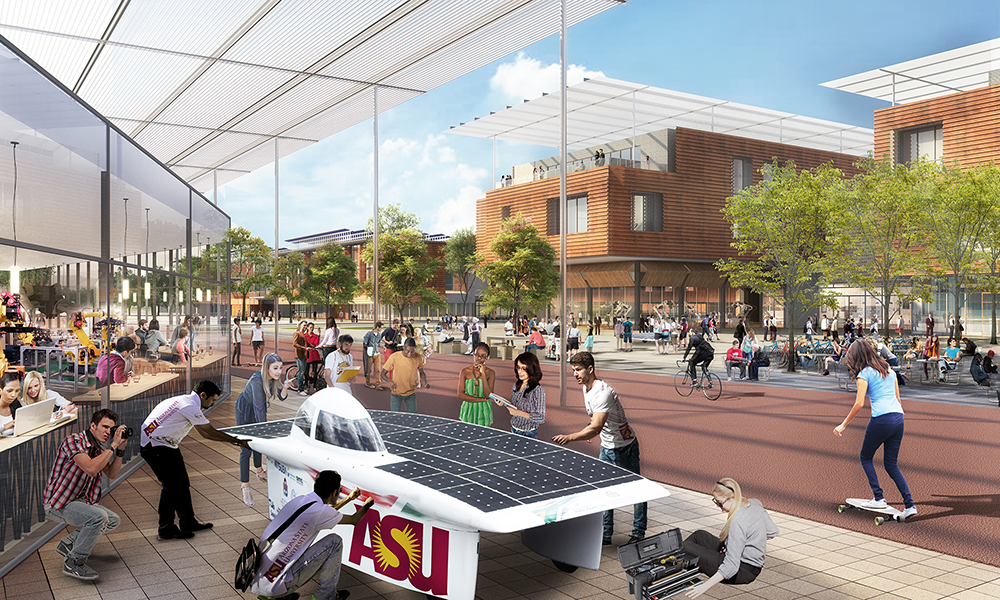
 Sasaki
Sasaki

By Caitlyn Clauson and Romil Sheth
This piece originally appeared in the July-September 2017 “Teaching and Learning” issue of SCUP’s Planning for Higher Education Journal (volume 45, issue 4).
Teaching and learning on campus is changing radically and rapidly as institutions seek to find their footing in a new paradigm. A decrease in federal funding for research is prompting institutions to find new and creative ways to educate students; continued hunger from the private sector for high-quality research has created new ties to industry; demand for applied learning has emerged from the need for real life experiences and connections to future jobs; the proliferation of startup culture and emergence of accessible technologies promote the fluid movement of ideas from the classroom to the marketplace, encouraging an entrepreneurial approach to learning.
The World Economic Forum (WEF) has articulated the idea of a Fourth Industrial Revolution in which technology like autonomous vehicles, AI, robotics, 3d printing, and bio-technology, will enable the blurring of traditional boundaries between the physical, digital, and biological realms—transforming our living and working environment. The WEF report observes, “When compared with previous industrial revolutions, the Fourth is evolving at an exponential rather than a linear pace. Moreover, it is disrupting almost every industry in every country. And the breadth and depth of these changes herald the transformation of entire systems of production, management, and governance.”
This revolution will undoubtedly lead to the development of an entirely new set of jobs that don’t exist today and some jobs that are commonplace today will disappear. To stay relevant, job seekers will need to keep abreast of these changes and ensure their skills are compatible. For many of today’s students, the academic degree serves increasingly as the vehicle toward engaging with this rapidly evolving and competitive marketplace in which students aspire to generate fresh ideas, start new businesses, create new products, and take risks.
Universities are similarly grappling with how to adapt, exploring different strategies to attract and retain a new kind of student and faculty, and equip them with the tools to succeed in the workplace of the future. Institutions are developing entirely new kinds of research and learning spaces that foster entrepreneurship and collaboration that break down traditional barriers between institutions and industry. Not only do these spaces facilitate hands-on learning and access to real world challenges but they also cultivate inter-disciplinary thinking, collaboration, and team work—skills and experiences that are essential to working in today’s dynamic workplace.
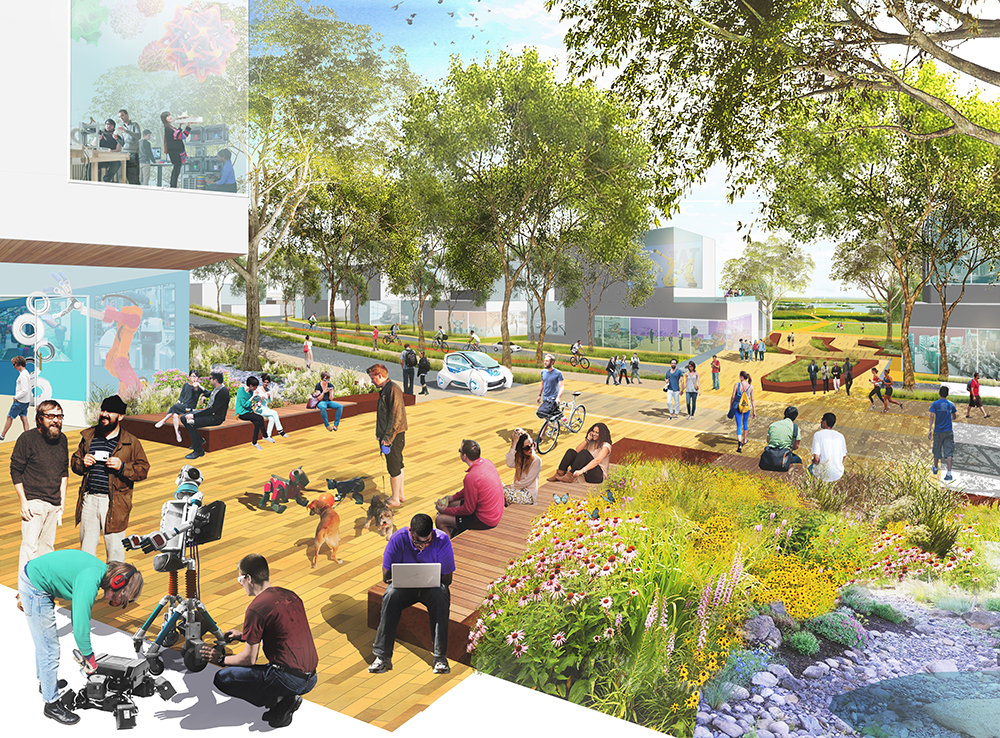
The innovation district at the University of Washington, Seattle creates spaces that nurture a culture of experimentation and entrepreneurship
While the idea of startup culture and an innovation mindset is relatively new, institutional integration with industry goes back decades. At the University of Washington (UW), the creation of industry-sponsored space has been part of its history. One of its longest and most collaborative partnerships started with a gift from the then young Boeing Company. William Boeing made a large donation to the UW in 1917 to construct a wind tunnel for testing plane models. In return, the University offered courses within the engineering department to develop skills that would be valuable to aeronautics companies, the Boeing Company in particular. Through much of the 20th century, the popularity of engineering and technology-related courses at the University grew alongside the success of the aerospace company. Numerous research collaborations, partnership opportunities and grants were made possible by the continued support of the Boeing Company. The investment of the company led to an educated workforce that contributed to larger innovations and opportunities in astronautics, aerospace, and government-sponsored research.
Microsoft has similarly contributed to the growth of computer science-related education over the past several decades. The company has both funded and collaborated on a number of initiatives that support the innovation and growth of computer science at the UW. In 2003, the Paul G. Allen Center for Computer Science & Engineering opened with support from Microsoft’s co-founder, and helped to transform the department into one of the nation’s top computer science programs. In the last few years Microsoft also partnered with the University to expand the computer science program and contributed $10 million toward the new Computer Science and Engineering Building.
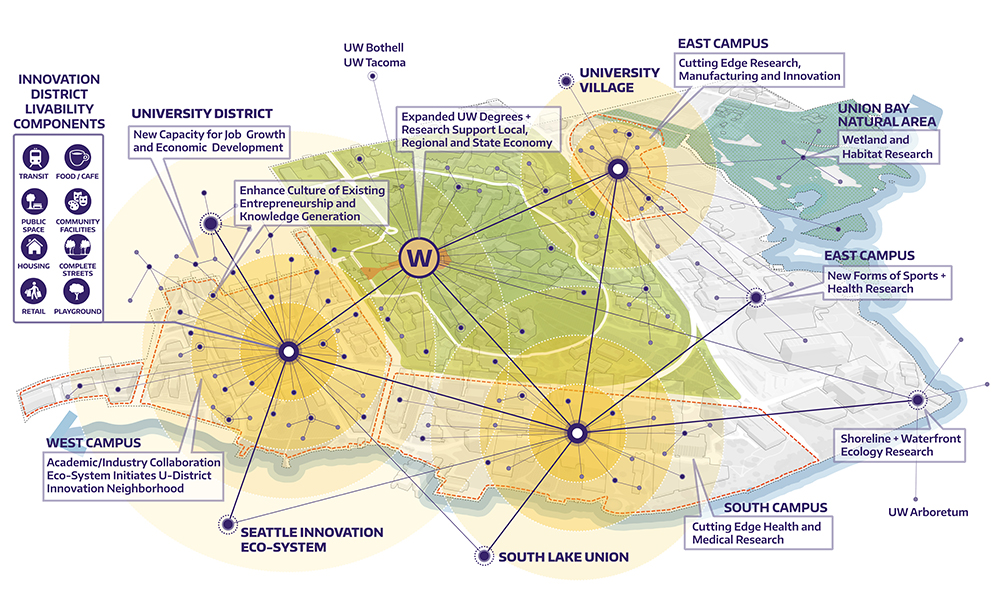
The University of Washington, Seattle master plan establishes a framework for collaboration internally within UW and externally with allied industry partners
In addition to these examples of intentional industry investment, startup culture and the idea of “student as entrepreneur” is expanding the vocabulary of learning spaces. The Bayh–Dole Act, or the Patent and Trademark Law Amendments Act of 1980, allowed academics in the US to patent their work, become entrepreneurs, and collaborate with industry. With the development of similar policies in Europe, partnerships between companies and university researchers around the globe have spiked. While this interaction traditionally happened in off-campus locations, there is now a growing trend to co-locate industry and university on campus. This adjacency breaks down barriers between industry and academia and creates a framework for a more open exchange of knowledge and ideas and becomes a natural extension of the learning process.
Consistently ranked #1 in entrepreneurship in the U.S. News Best Colleges Report, Babson College has been at the forefront of linking industry and academia. An award-winning hallmark of its unique academic program is Foundations of Management and Entrepreneurship (FME), which gives first-year students hands-on entrepreneurial experience. Students are placed in groups of 60 and collectively create a company to develop, market, and sell a product. They then liquidate the company and donate all profits to a charity of their choosing.
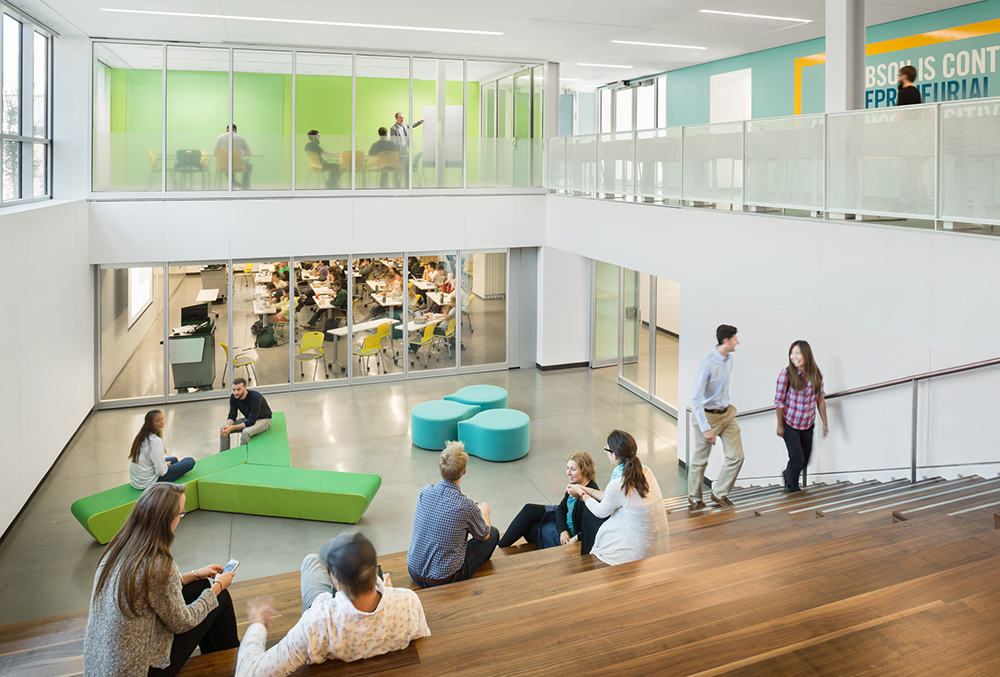
The innovation center at Babson housed within its residence hall creates a diversity of programmed and informal spaces to encourage collaboration and generation of new ideas
Babson’s new 200-bed Park Manor West residence hall, designed by Sasaki, includes the Leonard A. Schlesinger Innovation Center, to support Babson’s unique curriculum and mission. A collection of academic and social spaces—including the amphitheater, bench seating, a flex classroom, conference rooms and the Innovation Center—are located at the intersection of the two residential wings and form the heart of Park Manor West. The Innovation Center is open 24/7 and is the home of the first year FME program. Students can choose to work in a variety of open work spaces with configurable furniture on the ground floor and lounge seating on the second floor. Indoor/outdoor connections on three sides connect the life of the Innovation Center to the diverse landscapes created as part of the project. Floor-to-ceiling windows flood both levels with natural light and garage doors open up onto the entry terrace.
Babson’s culture of entrepreneurship extends beyond the first year. Instead of having student businesses run out of dorm rooms, space for startups is provided in the form of hatcheries. Undergraduate and graduate hatcheries are professional and semiprivate work spaces located throughout the campus and they function similar to incubators. Here, student businesses are part of the Butler Launch Pad, Babson’s signature co-curricular program designed to catalyze businesses and gain access to coaching and business development.
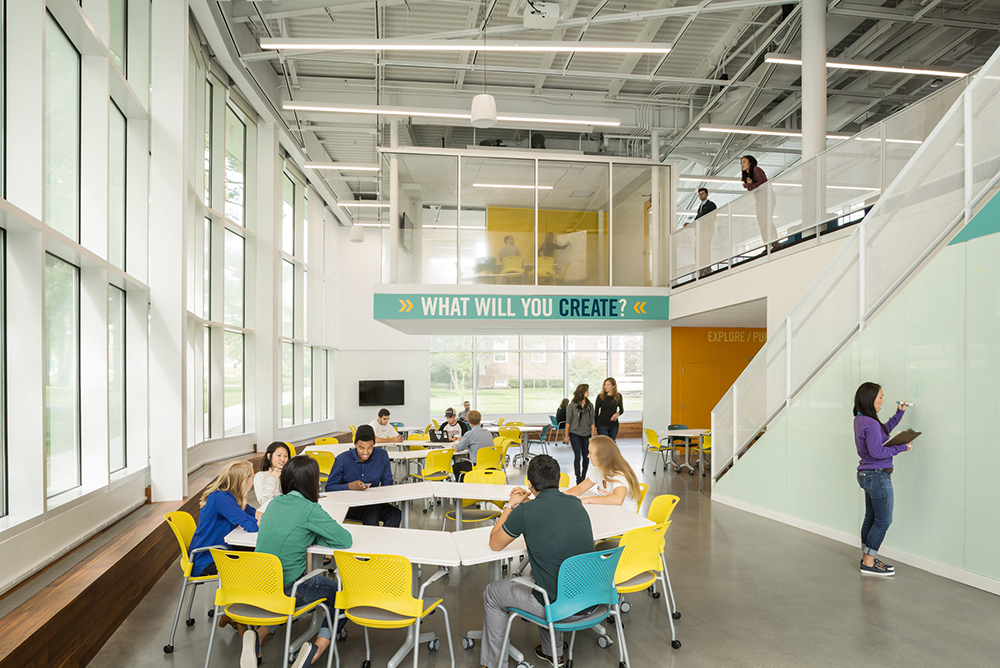
Writable surfaces, flexible furniture, high degree of visibility and accessibility facilitate interdisciplinary collaboration at the Babson college innovation center
On the other side of the nation, the University of Washington recently founded CoMotion, the University’s collaborative innovation hub dedicated to expanding the economic and societal impact of the UW community. “CoMotion provides the tools and connections UW researchers and students need to accelerate the impact of their innovations by helping students, teachers and researchers develop innovation mindsets focused on entrepreneurial thinking and problem solving.” CoMotion runs a network of multi-industry lab spaces across campus that host startups, entrepreneurs, innovators and artists both inside and outside the University; two such spaces include UW’s Fluke Hall and Startup Hall. Fluke Hall is home to CoMotion’s Incubator and Makerspace, a collection of offices, labs and collaborative spaces where startups can connect with industry, seek guidance and coaching, and accelerate their research.
Startup Hall was formed in 2013 in the University’s West Campus and developed out of a unique public-private partnership between the University of Washington and Techstars, the nation’s top startup accelerator, and Founder’s Co-op, a leading seed-stage venture capital fund. The space in the University’s former law school building has become fertile mixing ground to link students, researchers and industry; elevate research; and create new businesses.
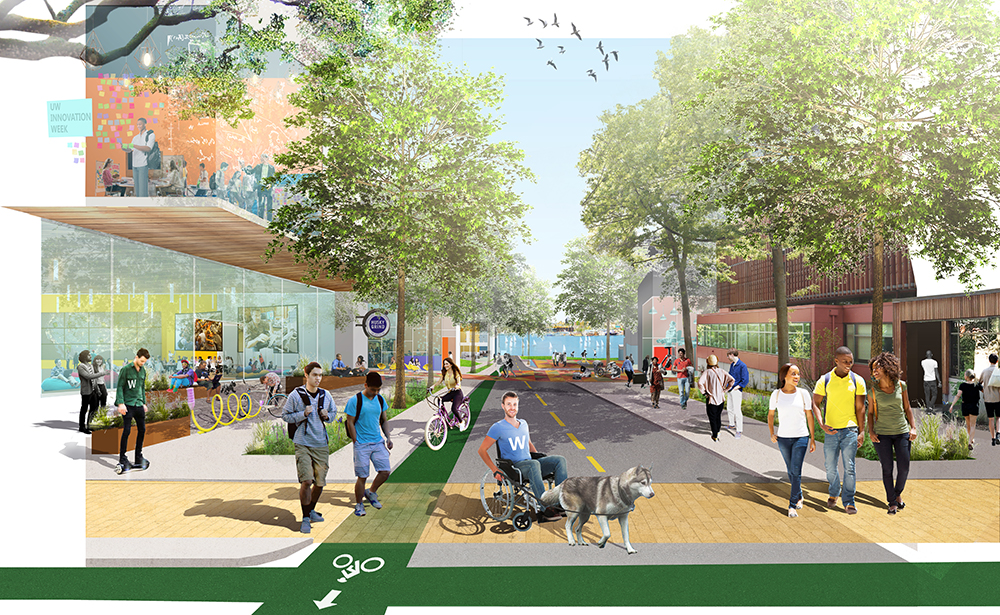
The University of Washington, Seattle master plan pays particular attention to the design of the public realm and activation of street edges to make innovation and learning visible and encourage serendipitous encounters
And in the Southwest, Arizona State University (ASU) has also consciously cultivated a series of institutes and centers to encourage entrepreneurship and foster collaboration with allied industries across their different campuses. The Fulton School of Engineering located on ASU’s polytechnic campus in Mesa includes 20 research centers that engage a diverse array of opportunities—from algae technologies to photonic innovation. These centers are supported by the “startup village” that is described as an “entrepreneurship focused community helping to grow and support entrepreneurs and the startup ecosystem.” Initiated in 2013 by both students and faculty, this village provides a collaborative setting for student entrepreneurs to develop startups, learn from each other, and get mentoring from professors and successful entrepreneurs.
On other ASU campuses, the University has introduced spaces that support its broader mission for innovation and experimentation. The “Idea Box” is a mobile unit that travels to the various ASU campuses connecting students with available resources and creating opportunities for students to share their ideas with the campus and broader community. The “New Media Innovation and Entrepreneurship Lab” is another example in which journalism students collaborate with computer engineering, design, and business students to “create cutting-edge digital media products for regional and national media companies and other organizations.”

The master plan for Arizona State University develops new types of collaborative, multi-disciplinary spaces and buildings that facilitate both indoor and outdoor testing and experimentation
While the previous examples highlight specific spaces that foster entrepreneurial thinking, their collective momentum is prompting the creation of larger-scale innovation districts where institutions, allied industry, public and private come together. Within this context opportunities for learning are exponential, and the public realm takes on a critical role.
Arizona State University (ASU) recently completed a master plan with Sasaki for a research district near its polytechnic campus designed to spur innovation and forge partnerships with allied industry. The master plan creates a new paradigm of hands-on learning that integrates labs and test-beds in a series of mixed-use clusters that are tied together by a continuous public realm, creating a spine of collaboration. The test-beds actively promote full scale testing and prototyping of on-going research and also include a “sand box” for faculty and student projects. The spine weaves through both the test-beds and research clusters providing access, making research visible, and creating opportunities for serendipitous interactions. A collaborative multi-disciplinary building located on the campus forms a gateway to the research district and houses academic, incubator, and maker spaces. The intent is to create a center that catalyzes innovation by focusing on problem-based multi-disciplinary inquiry that is informed by active partnerships with industry and enabled by a host of available research grants and funding.
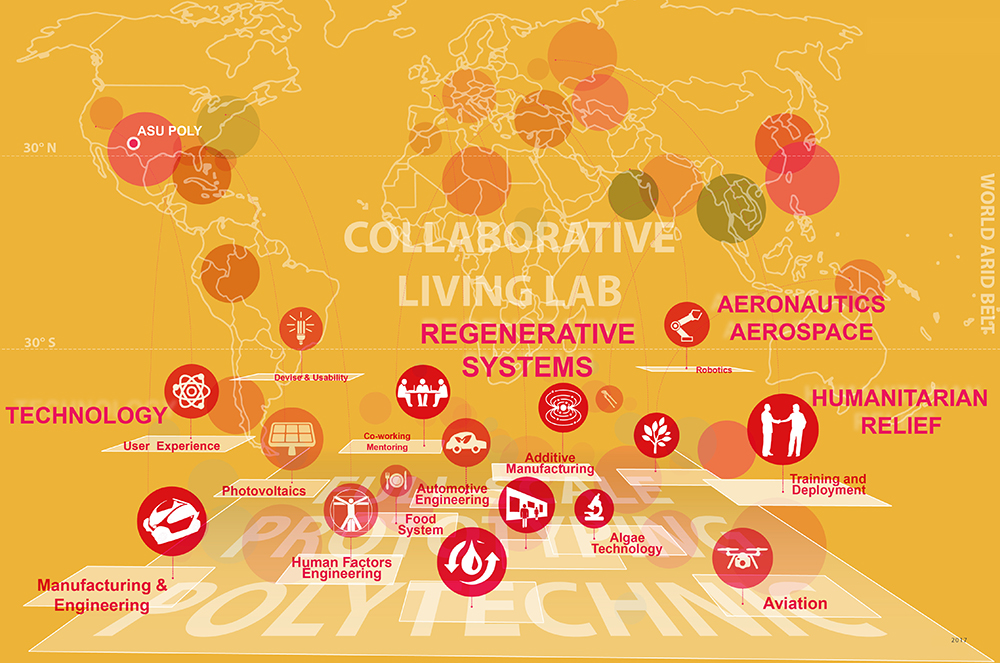
The innovation district at Arizona State University is rooted in a unique identity focused around research and experimentation in regenerative systems
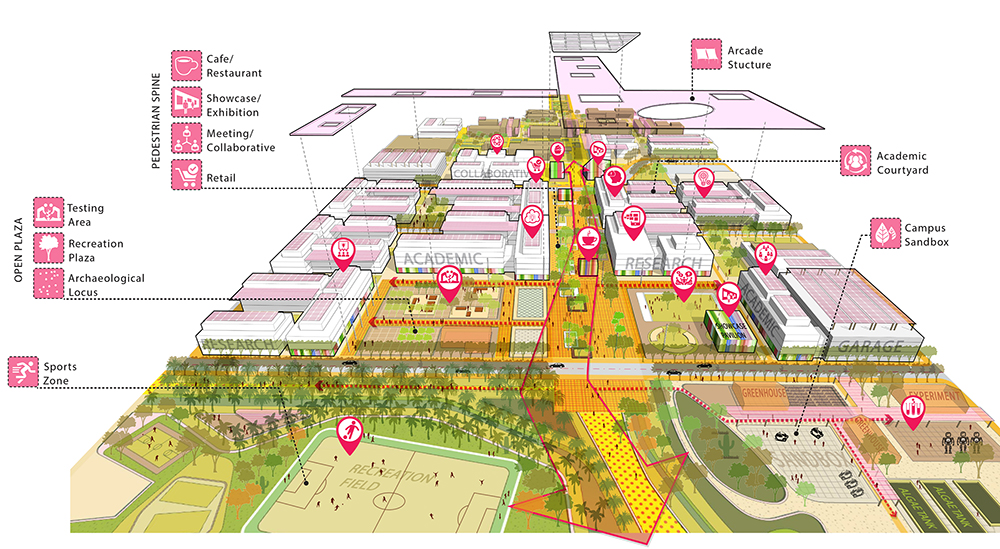
At Arizona State University academic spaces, research, allied industry and full scale proto-typing and testing areas are highly intertwined in a compact configuration and connected via a shaded public realm that addresses the hot arid climate of the region
The TechTown Innovation District serves as another example. TechTown encompasses three anchor institutions in Midtown Detroit including Wayne State University, Henry Ford Health Systems, and the College for Creative Studies. Each anchor institution had previously prepared individual development plans, but they did not consider their potential collective impact. Sasaki’s master plan for the district creates a unified framework that supports the unique needs of each institution, while leveraging opportunities for shared amenities, concentrating activity, and creating a distinct district identity. The plan supports the institutions’ collective desire for collaboration, experimentation, and hands-on applied learning, situated within a safe, active, and vibrant neighborhood.
While new ideas are often the product of collaboration and spontaneous conversations, institutions in TechTown largely operated as internalized siloes that rarely engaged the public realm or nearby organizations. The shift toward a new innovation economy requires places for collaboration, including landing spots for planned and serendipitous meetings, ad hoc gathering spaces, and flexible and temporary spaces. The TechTown Innovation District Plan brings these elements together within a central plaza that forms a defined heart for the district. Through a robust open space framework and urban design strategy, the plan transforms places previously dominated by cars into places for people, while creating a clearly defined heart and visual identity for the district. Engaging civic spaces and a carefully curated public realm program encourage participation, creation, and collaboration.
While innovations occur daily in TechTown, experimental infrastructure such as co-working spaces, incubators, fabrication labs, hacker labs, and test kitchens are limited to specialized institutions and are not accessible to a broader audience. The plan for TechTown situates these spaces in central, highly visible, and accessible locations that span both indoor and outdoor environments—encouraging inquiry, while activating the public realm in a thought-provoking and participatory manner. Experimentation and hands-on learning are encouraged with a fabrication lab and fabrication tables that anchor the southern side of the plaza and bring learning and product development outdoors. Elements such as a projection screen, a climbing wall, campfires and a café with seating among an informal grove of trees, are all designed to attract knowledge and creative workers to the heart of the district. These amenities compliment a nearby flexible space that can be programmed according to time of year and community needs. The importance of the public realm as a crucible for new ideas and a catalyst for learning cannot be emphasized enough.

At TechTown a series of under utilized surface parking lots are re-imagined as a flexible public space that creates a new identity for the district and a forum for experimentation and hands on learning
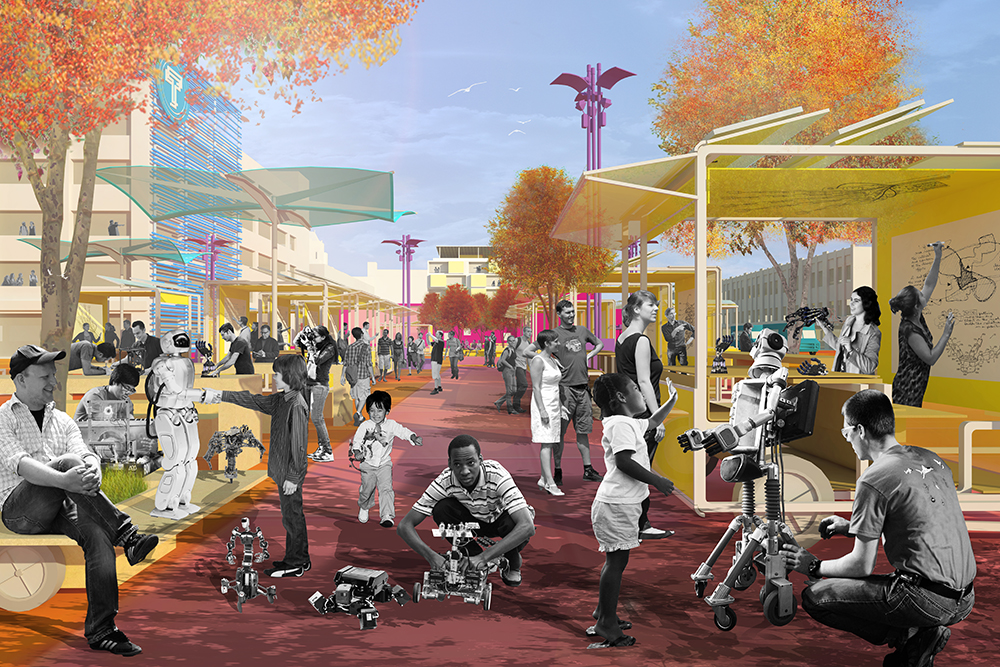
A series of adapatible and deployable ‘collaboration cubes’ allow multiple permutations for configuring the public space and a diversity of activities and social engagement
Learning by creating is a revolutionary force in which ideas of prototyping, disrupting, hacking, and making are becoming the norm in both education and the work place. This movement and recent changes in funding streams are creating great opportunities for universities to re-think traditional models, break down silos, and engender new forms of multi-disciplinary thinking and collaboration that tie the university’s broader educational mission to student entrepreneurship.
Meaningful partnerships with allied industries is increasingly being recognized and adopted to fund and advance research, accelerate transfer of research into the marketplace, create new ways of learning and interning for students and stimulate economic development.
Active university industry partnerships are also re-positioning universities as progressive learning environments that are very different from conventional classroom settings and leading to the development of a diverse array of new spaces. These spaces harness the university’s depth of academic and research talent with resources and access from industry partners to develop cutting edge research, attract talented students and faculty and create an avenue for future employment.
These spaces and collaborations are not limited to a few disciplines. Instead, they are becoming increasingly more pervasive as universities re-imagine traditional space types, become more multi-disciplinary, embrace entrepreneurship, and address critical challenges facing our world.